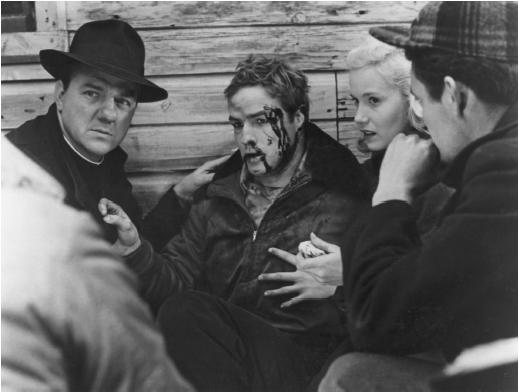 On the Waterfront, critically acclaimed to be an outstanding, gritty drama portraying a life of corruption on the New York City docks. A low budget film, released June of 1954, the winner of 8 Oscars, this film captures the real hardships and corruption of the working man in a New York ship yard. Marlon Brando creates the character of an ex-fighter, who is very rough around the edges, yet has a sensitive side. He finds himself caught in the middle of a moral dilemma of what he is supposed to do, and what he should do. The film starts out with Terry (Brando) setting up Joey Doyle to go on the roof, to get a little talking to. Little did Terry know that Johnny Friendly, the waterfront mobster, was planning on pushing him off the building and killing him. This scene shot in low-key lighting gives the first clues that Terry, even though involved in the gang, still has a moral code and is affected by the mobs wrong doings. This scene also introduces Joey’s sister, Edie (Eva Marie Saint) who later while trying to bring justice to the docks, with the help of Father Berry (Karl Malden) falls in love with Terry Malloy. In these grimy docks, Johnny Friendly’s mob has control over everyone’s life; there is a rule that everyone must act D and D, deaf and dumb. They don’t hear anything or see anything, making it possible for the mob to have all control over work, wages and their lives. With the murder of Joey and another shipyard worker, Father Barry, Edie and other try to stop this corruption.
On the Waterfront, critically acclaimed to be an outstanding, gritty drama portraying a life of corruption on the New York City docks. A low budget film, released June of 1954, the winner of 8 Oscars, this film captures the real hardships and corruption of the working man in a New York ship yard. Marlon Brando creates the character of an ex-fighter, who is very rough around the edges, yet has a sensitive side. He finds himself caught in the middle of a moral dilemma of what he is supposed to do, and what he should do. The film starts out with Terry (Brando) setting up Joey Doyle to go on the roof, to get a little talking to. Little did Terry know that Johnny Friendly, the waterfront mobster, was planning on pushing him off the building and killing him. This scene shot in low-key lighting gives the first clues that Terry, even though involved in the gang, still has a moral code and is affected by the mobs wrong doings. This scene also introduces Joey’s sister, Edie (Eva Marie Saint) who later while trying to bring justice to the docks, with the help of Father Berry (Karl Malden) falls in love with Terry Malloy. In these grimy docks, Johnny Friendly’s mob has control over everyone’s life; there is a rule that everyone must act D and D, deaf and dumb. They don’t hear anything or see anything, making it possible for the mob to have all control over work, wages and their lives. With the murder of Joey and another shipyard worker, Father Barry, Edie and other try to stop this corruption.Marlon Brando in the role of Terry Malloy gives a riveting performance both rough and tumble, yet soft around the edges. Brando executes an, I don’t give a damn, attitude but also the film sneaks in a childish, and sensitive side to Terry. For instance he climbs up to his roof to check on his pigeon coop where he looks after them with two young boys. While leaving to go meet with the mob, he tells the boys not spill any water, because he doesn’t want to the birds to get sick. Expressing somewhat of a contradiction of character, Brando gives an outstanding, multi-faceted performance.
Another reason why I think that this film won 8 Oscars was for the lighting and camera angles. Many of the scenes involving the mob were set in low-key lighting giving setting a serious tone, and also giving the viewer an uneasy feeling, not really knowing what would come next. Lighting was also a critical element in Terry and Edie’s relationship, while the lighting for Terry was always a little darker, almost in the shadow, Edie’s was always bright and a somewhat warm light. This not only literally but visually described how Terry was rough and thought only of himself, while Edie was kind, thoughtful and always thinking of others. This contrast in characters created a great chemistry on screen and was also a catalyst for Terry to start standing up for himself, and getting what he deserved. In the scene where Terry finds his brother Charlie murdered, lighting plays a very important role in portraying that emotion of loss. The ally is completely dark, except for one bright street light, shining on Charlie’s body. With the use of a long shot, it creates and overwhelming emotion of despair and hopelessness.
Camera angles were also very important in showing the power each person has to stand up to what wrong. In the scene where Father Barry is praying over a dead worker, killed by the mob. Father Barry is shot in a high-angle on a dock below everyone and is preaching to the mob. This is a very powerful shot expressing the fact that even though the mob may seem powerful, they can be defeated.
I think that the movie On the Waterfront deserves more than 8 Oscars. It was a powerful film that dealt with harsh realities, the plot had many layers as well as the characters and it kept you on the edge of your seat. Marlon Brando’s performance as well as Eva Marie Saint’s made this movie what it is, a film about how an underdog can overcome, and to never sell your self short.
No comments:
Post a Comment